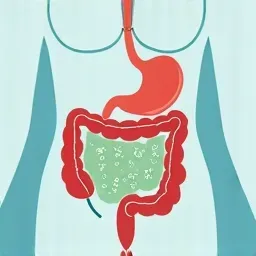SIBO Explained: Understanding Small Intestinal Bacterial Overgrowth

SIBO Explained: Understanding Small Intestinal Bacterial Overgrowth
If you've been experiencing persistent bloating, abdominal pain, and digestive issues that seem to defy explanation, you might be dealing with a condition called Small Intestinal Bacterial Overgrowth, or SIBO. Despite affecting millions of people worldwide, SIBO remains one of the most misunderstood and underdiagnosed digestive conditions.
This comprehensive guide will help you understand what SIBO is, how to recognize its symptoms, and what treatment options are available to help you reclaim your digestive health.
What Is SIBO?
Small Intestinal Bacterial Overgrowth (SIBO) occurs when there is an abnormal increase in the overall bacterial population in the small intestine—particularly types of bacteria not commonly found in that part of the digestive tract [1]. This condition is sometimes called blind loop syndrome.
To understand SIBO, it's helpful to know how your digestive system normally works. Your small intestine, which measures about 20 feet long, is where most nutrient absorption takes place [2]. Unlike your large intestine (colon), your small intestine normally has relatively few bacteria due to the rapid flow of contents and the presence of bile [2].
In healthy individuals, the concentration of bacteria in the small intestine rarely exceeds 1,000 organisms per milliliter [1]. However, when protective mechanisms fail, bacteria can multiply excessively, leading to SIBO.
Recognizing SIBO Symptoms
SIBO symptoms can be frustratingly similar to other digestive conditions, which often leads to misdiagnosis. The most common signs and symptoms include [1][2]:
- Bloating and abdominal distension - Often the most prominent symptom
- Abdominal pain or discomfort - May be cramping or aching
- Diarrhea - Often chronic and watery
- Excessive gas and flatulence - Due to bacterial fermentation
- Nausea - Especially after eating
- Loss of appetite - Leading to unintentional weight loss
- Feeling of fullness after eating - Even small amounts of food
In more severe cases, SIBO can lead to malnutrition and vitamin deficiencies, particularly B12, which can cause weakness, fatigue, and neurological symptoms [1][2].
What Causes SIBO?
SIBO develops when the body's natural protective mechanisms against bacterial overgrowth fail. Several factors can contribute to this condition [1]:
Impaired Gut Motility
Normal intestinal contractions, called migrating motor complexes, help sweep bacteria through the digestive tract. Conditions that slow this process—such as diabetes, hypothyroidism, or scleroderma—can predispose someone to SIBO [1].
Structural Abnormalities
Physical changes to the digestive tract can create environments where bacteria can accumulate. These may include [1][2]:
- Intestinal adhesions from previous surgery
- Small intestinal diverticulosis
- Strictures or narrowing of the intestine
- Gastric bypass surgery
Reduced Stomach Acid
Stomach acid normally helps destroy bacteria before they reach the small intestine. Conditions causing low stomach acid (achlorhydria) or medications like proton pump inhibitors can increase SIBO risk [1].
Immune System Issues
The immune system, particularly secretory IgA, helps maintain proper bacterial balance. Immunodeficiency disorders can increase susceptibility to SIBO [1].
Underlying Medical Conditions
Certain conditions are strongly associated with SIBO, including [1][2]:
- Crohn's disease
- Irritable bowel syndrome (IBS)
- Celiac disease
- Chronic pancreatitis
- Radiation enteritis
SIBO and IBD: A Complex Relationship
Recent research has revealed a significant connection between SIBO and inflammatory bowel disease (IBD). A comprehensive meta-analysis of 29 studies involving over 3,250 IBD patients found that nearly one-third (31%) of IBD patients have SIBO—a rate 5.25 times higher than healthy individuals [3].
The study identified several predictors of SIBO in IBD patients, including [3]:
- Lower body mass index (BMI)
- History of abdominal surgery
- Increased bloating and flatulence
- Stricturing or penetrating disease patterns in Crohn's disease
This connection suggests that SIBO may contribute to ongoing symptoms in IBD patients, even when their underlying inflammatory condition appears well-controlled.
How Is SIBO Diagnosed?
Diagnosing SIBO can be challenging because there's no single "gold standard" test. The most commonly used diagnostic methods include [1]:
Breath Tests
These non-invasive tests measure hydrogen and methane gases produced by bacteria when they ferment carbohydrates. The two main types are:
- Glucose breath test: Uses glucose as the substrate
- Lactulose breath test: Uses lactulose, a synthetic sugar
A positive result typically shows a rise of more than 20 parts per million in hydrogen within 90 minutes, or methane levels above 10 parts per million [1].
Jejunal Aspirate Culture
This involves taking a sample of fluid from the small intestine during an upper endoscopy. While considered more accurate, it's invasive, expensive, and not widely available [1].
Treatment Options for SIBO
SIBO treatment typically involves a multi-pronged approach focusing on reducing bacterial overgrowth and addressing underlying causes [1]:
Antibiotic Therapy
Antibiotics remain the primary treatment for SIBO. Common options include [1]:
- Rifaximin: Often first-line treatment, especially for hydrogen-predominant SIBO
- Metronidazole: Effective against anaerobic bacteria
- Ciprofloxacin: Broad-spectrum antibiotic
- Neomycin: Often combined with rifaximin for methane-predominant SIBO
Treatment typically lasts 10-14 days, with success rates varying from 60-90% depending on the antibiotic used and patient factors [1].
Dietary Modifications
While not curative alone, dietary changes can help manage symptoms:
- Elemental diet: Pre-digested nutrients that are absorbed quickly, leaving little for bacteria to ferment
- Low-FODMAP diet: Reduces fermentable carbohydrates that feed bacteria
- Specific carbohydrate diet: Eliminates complex carbohydrates
Addressing Underlying Causes
Long-term success requires treating conditions that predispose to SIBO, such as [1]:
- Optimizing treatment for diabetes or thyroid disorders
- Managing inflammatory bowel disease
- Considering surgical correction of anatomical abnormalities
- Reviewing medications that may contribute to SIBO
The Challenge of SIBO Recurrence
One of the most frustrating aspects of SIBO is its tendency to recur. Research shows that approximately 45% of patients experience recurrent SIBO following antibiotic therapy, with higher rates in older adults and those with certain risk factors [1].
For patients with frequent recurrences (more than 4 episodes per year), healthcare providers may consider antibiotic prophylaxis—taking antibiotics for 5-10 days every two weeks or monthly [1].
When to Seek Medical Help
You should consult a healthcare provider if you experience [1][2]:
- Persistent bloating and abdominal pain
- Chronic diarrhea lasting more than a few weeks
- Unexplained weight loss
- Signs of malnutrition or vitamin deficiencies
- Symptoms that significantly impact your quality of life
Early diagnosis and treatment can prevent complications and improve your overall digestive health.
Living with SIBO: A Path Forward
While SIBO can be a challenging condition to manage, understanding your triggers and working closely with a knowledgeable healthcare provider can lead to significant symptom improvement. Many patients find that a combination of appropriate antibiotic treatment, dietary modifications, and addressing underlying conditions helps them regain control over their digestive health.
Remember that SIBO treatment is often a process rather than a quick fix. Be patient with yourself and your healthcare team as you work together to find the most effective approach for your individual situation.
Key Takeaways
- SIBO occurs when bacteria overgrow in the small intestine, causing bloating, pain, and digestive issues
- It's often associated with underlying conditions like IBD, diabetes, and structural abnormalities
- Breath tests are the most common diagnostic tool, though they're not perfect
- Antibiotic therapy is the primary treatment, often combined with dietary changes
- Addressing underlying causes is crucial for preventing recurrence
- Early diagnosis and treatment can prevent complications and improve quality of life
References
- Sorathia SJ, Chippa V, Rivas JM. Small Intestinal Bacterial Overgrowth. StatPearls [Internet]. Treasure Island (FL): StatPearls Publishing; 2023. Available from: https://www.ncbi.nlm.nih.gov/books/NBK546634/
- Mayo Clinic Staff. Small intestinal bacterial overgrowth (SIBO) - Symptoms & causes. Mayo Clinic. 2024 Nov 11. Available from: https://www.mayoclinic.org/diseases-conditions/small-intestinal-bacterial-overgrowth/symptoms-causes/syc-20370168
- Feng X, Hu J, Zhang X. Prevalence and predictors of small intestinal bacterial overgrowth in inflammatory bowel disease: a meta-analysis. Front Med. 2025 Jan 21;11:1490506. Available from: https://www.frontiersin.org/journals/medicine/articles/10.3389/fmed.2024.1490506/full
Disclaimer: This article is for educational purposes only and is not intended as medical advice. Always consult with a qualified healthcare provider for proper diagnosis and treatment of any health condition.



